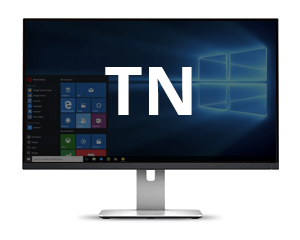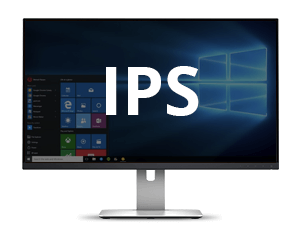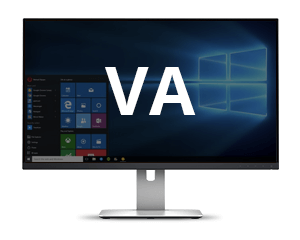Monitors For Every Purpose
The monitor is perhaps the most important element of any computer setup, you spend all the time you are at your PC looking at it and it directly impacts on the experience you have with your computer. Unfortunately the monitor is also often the most overlooked component. There are screens available for every purpose and budget, with good quality Full HD resolution screens available for under £100. Here at CCL you will find the right monitor for your needs and we are more than happy to guide you through your purchase, get in touch with us if you need any advice.
What panel types are available?
There are three main panel technologies currently in use in LCDs. They are twisted nematic (TN), vertical alignment (VA) and in-plane switching (IPS). The majority of all the screens made by the large manufacturers are based on the TN panels due to their cost.
 |  |  |
TN Panels TN panels have the advantage of ultra-fast response times (measured in ms) and cheaper cost. The major disadvantage of TN monitors are narrow viewing angles, lower brightness levels and decreased colour reproduction. Shop TN Panels | IPS Panels IPS based monitors have the best viewing angles of all the panel types and produce by far the most accurate colours; however the black level is slightly behind that of a VA based screen. IPS screens normally have slower response times. Shop IPS Panels | VA Panels VA screens offer improved viewing angles when compared to TN monitors, better colour reproduction and typically have a much higher maximum brightness level. VA screens offer excellent all round performance. Shop VA Panels |
What is Response Time?
All LCD monitors will have an attribute called 'Response Time' which is measured in ms (milliseconds). The 'Response Time' is the indication of how fast a pixel changes from colour to colour. Current monitors can achieve a 'Response Time' of as fast as 1ms which produce the best video quality, hence why they are popular among gamers. Ultra-Fast Response Times reduce "ghosting" in moving images. Ghosting occurs in slow 'Response Time' monitors where slow colour changes produce blurry or fuzzy moving images as pixels cannot keep up.
 |  |
Ultra-Fast Response Time (ms) 1-2 ms 'Response Time' is key to ultra-smooth video and gaming. It reduces ghosting and blurring, providing a sharp picture. | Slow Response Time (ms) Monitors with slower 'Response Times' suffer from ghosting in fast moving images. |
What is Refresh Rate?
A monitor's 'Refresh Rate' refers to how many times a monitor updates or "refreshes" a new image each second and is measured in Hz (Hertz). For example a standard 60Hz monitor will refresh the image 60 times per second. However, a 144Hz monitor will refresh the image 144 times per second, leading to incredibly smooth motion. Some high end monitors can go up to 240Hz refresh rate.
It is very difficult to illustrate the difference between refresh rates using a still image as it mainly refers to moving objects on-screen. Imagine two scenes from a stop motion animation, one scene has 120 images of a moving object and another has 25 images. The scene with more images will provide much smoother motion. When it comes to gaming a higher 100Hz+ 'Refresh Rate' with sub 4ms 'Response Time' is preferred, especially in competitive games and eSports titles such as CS:GO. High 'Refresh Rate' monitors are able to keep up with the player's movement for a more responsive experience. However generally speaking, a 60Hz display is still the most common among gamers.
Resolution & Size - which one is right for you?
The resolution of a monitor is dictated quite heavily by the monitor size. Normally the bigger the monitor you purchase the higher its resolution will be, the higher the resolution of the screen the better the fonts and sharpness of the picture will look. At higher resolutions items appear sharper yet they also appear smaller so more items can fit on the screen.
Pixel Density
There is a noticable difference between picture quality of a 24" monitor and a 32" monitor if they both have a 1080p Full HD resolution. A 32" 1080p monitor will have the same amount of pixels but spread over a larger screen size, reducing pixel density, however, this becomes less noticable the further away you are from the screen. Similarly, a 4K monitor with a screen size of 28" will have increased pixel density and ultra-sharp image quality.
Most Common Resolutions:
| 4K Ultra HD (UHD) | 3,840 x 2,160 |
| Quad HD (QHD) | 2,560 x 1,440 |
| 1080p Full HD (FHD) | 1,920 x 1,080 |
| 720p HD | 1,280 x 720 |
Ports - what should you look for?
When purchasing a monitor one of the important features to consider are the included monitor ports. Many years ago monitors would primarily use a standard Video Graphic Array (VGA) or SuperVGA (SVGA) connection with two screws to keep the cable in place. A modern monitor now features various types of ports, each one with unique attributes. It is important that you choose the monitor with correct ports and appropriate video cables.
For example, if you are shopping for a 1440p 144Hz you will require a correct video cable in order to achieve the monitor's full potential.

| Port Type | Max Resolution | Refresh Rate (Hz) | Audio Signal |
| VGA | 2048 x 1536 | 85Hz | - |
| HDMI 1.4b | 4K (3840 x 2160) | 30Hz (4K), 75Hz (1440p), 144Hz (1080p) | Yes |
| HDMI 2.0b | 4K (3840 x 2160) | 60Hz (4K), 144Hz (1440p), 240Hz (1080p) | Yes |
| HDMI 2.1 | 10K (10240 x 4320) | 30Hz (8K), 144Hz (4K) | Yes |
| DVI-D Single Link | 1920 x 1200 | 60Hz | - |
| DVI-D Dual Link | 2560 x 1600 | 75Hz (1440p), 144Hz (1080p), | - |
| DisplayPort 1.4a | 8K (7680 x 4320) | 30Hz (8K), 60Hz (5K), 120Hz (4K), 240Hz (1440p) | Yes |
BACK TO TOP ^^








